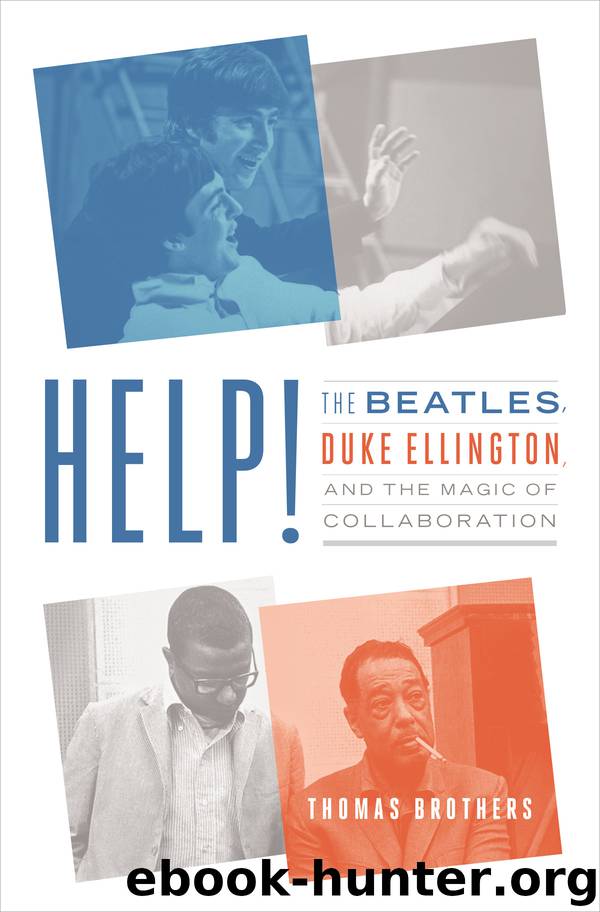Help! by Thomas Brothers

Author:Thomas Brothers
Language: eng
Format: epub
Publisher: W. W. Norton & Company
Published: 2018-09-27T16:00:00+00:00
5.4 Chuck Berry, 1950s
I Saw Her Standing There was directly inspired by Chuck Berry, the lyrics from Little Queenie and the opening chord, the guitar riff, and the boogie-woogie bass from I’m Talking about You. In Liverpool the Beatles came to be known as Chuck Berry specialists. Relative to Berry, I Saw Her Standing There is faster and more aggressive. McCartney’s opening phrase also has more musical definition than the counterpart. Lennon added the sly suggestion that the listener knows what the singer means about the girl being just seventeen, an early example from a long list of lyric upgrades for his partner’s works in progress. This is not just a better line: it is an invitation to the listener to take the song as an intimate moment of storytelling.
Musical form may seem like a dry, abstract matter that shouldn’t have anything to do with racially marked culture, but it did. The bridge, the contrasting section in AABA form that makes the return to A sound fresh, pointed in the hi-fi direction, while a simple succession of blues choruses indexed vernacular practice, where the emphasis was not on elegant design but easy participation and performer-based intensity. It is not that musicians always did things one way or another, rather that these marked tendencies could be manipulated and used purposefully.
Lennon’s I Feel Fine is a classic demonstration of the Beatles landing on the side of white pop in the area of musical form. He was inspired by a riff from Watch Your Step (1961), by Bobby Parker, who was in turn inspired by Ray Charles’s What’d I Say (1959). (Lennon knew both records thoroughly and referred to Watch Your Step as “son of What’d I Say.”) Listening to the recordings in chronological sequence provides a lot of insight into how the blending Beatles positioned themselves.
The first thing to do is track the riffs, where each composition began. They are obviously connected. Following Lennon’s lead, Starr adapted drum patterns from the Charles and Parker recordings to combine with the riff and form a vigorous groove. In vocal qualities, the Beatles differ strikingly from their models. Charles and Parker sing with vocal ornaments that would have been at home in the black church, while Lennon delivers his melody fairly straight, with only slight blues inflections. Charles and Parker interact with their backup singers in call and response, again connecting to communal practices, while Lennon’s lead is simple enough for his companions to add direct harmonies in the fashion of the Everly Brothers (just like the McCartney brothers had done at home).
But the most startling moment comes when Lennon breaks out of the verse and into the bridge (“I’m so glad . . .”). If you first listen to the Charles and Parker recordings, which have no bridge, this comes as a shock. This formal difference creates, all by itself, a huge gap between I Feel Fine and music more firmly aligned with the African American vernacular. It reveals the Beatles’ enthusiasm for the craftsmanlike, fait parfait designs of the hi-fi songwriters.
Download
This site does not store any files on its server. We only index and link to content provided by other sites. Please contact the content providers to delete copyright contents if any and email us, we'll remove relevant links or contents immediately.
| Coloring Books for Grown-Ups | Humor |
| Movies | Performing Arts |
| Pop Culture | Puzzles & Games |
| Radio | Sheet Music & Scores |
| Television | Trivia & Fun Facts |
The Social Psychology of Inequality by Unknown(2990)
Make Comics Like the Pros by Greg Pak(2884)
Stacked Decks by The Rotenberg Collection(2846)
Purple Hibiscus by Chimamanda Ngozi Adichie(2744)
The Queen of Nothing by Holly Black(2547)
The Art of Doom by Bethesda(2131)
Life of Elizabeth I by Alison Weir(2054)
Putin's Labyrinth(1990)
The Power of Habit: Why We Do What We Do in Life and Business by Charles Duhigg(1970)
Drawing Down the Moon by Margot Adler(1844)
Things Are What You Make of Them: Life Advice for Creatives by Adam J. Kurtz(1835)
Agency by William Gibson(1801)
Wall and Piece by Banksy(1800)
Art Of Atari by Tim Lapetino(1774)
Teaching to Transgress: Education as the Practice of Freedom (Harvest in Translation) by Bell Hooks(1744)
The Beatles Lyrics by Hunter Davies(1695)
The Pin-Up Art of Bill Ward by Bill Ward(1675)
Only What's Necessary: Charles M. Schulz and the Art of Peanuts by Chip Kidd(1668)
The Andy Warhol Diaries by Andy Warhol(1579)
